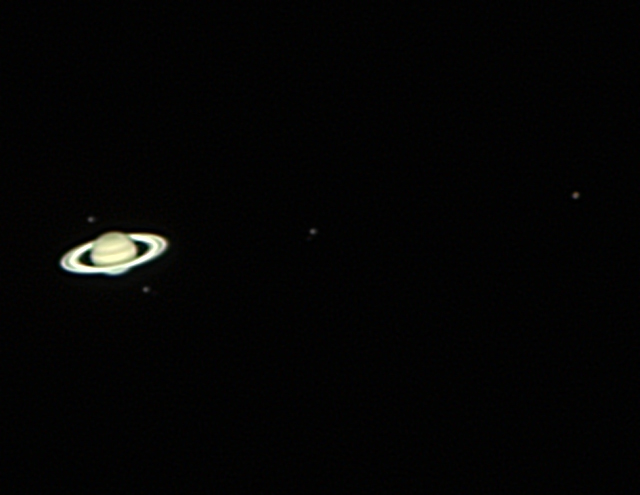
Saturn

Saturn is captured here together with 4 faintly visible moons which I have been unable to identify (see below). The Cassini division separating the A and B rings is clearly visible and in the native image, I imagined that I could see the inner Encke division although digital brightening of the image has lost this feature. Surface markings on the planet (circumferential bands) are also evident. No filters were used. This photo was taken between 1.45am and 2.45am on the 21st of January, 2006, 7 days before full opposition. Saturn orbits 1430 million km from the Sun, 9.5 times further than from the Sun than the Earth. The image is inverted so it is the south pole which is visible, the north being tilted away. The night was lightly windy and temperatures remained above freezing in spite of the sky being completely clear! The moon was very low on the eastern horizon and just approaching final quarter.
No focal reducer was used to maximise magnification and the native focal length of my SCT is f10. The Meade LPI was set initially to take exposures of 0.088 seconds, and later 0.126 seconds with adjustment of the dark contrast settings to reduce 'blooming'. This photo is a summation of 3 separate stacks as follows: 111 x 0.088secs, 70 x 0.126secs and 160 x 0.126secs, making up a total exposure time of 38.7 seconds. I have no manuals or instructions on digital enhancement of planetary digital photographs so very little processing was carried out after the image was summed - mid and high levels were brightened by using the Levels command in Photoshop and some unsharp mask was applied (150%, radius = 2, threshold = 20)
Addendum (02/06/06): many thanks to Lee Hodge, and the most brilliant astronomy software he recommended to me, Stellarium (www.stellarium.org), the 4 moons have now been identified. The furthest out is, of course, Titan. Next in is Rhea. Over the north of Saturn is Tethys and to the south is Dione. Remember that with an SCT, the picture is inverted, so the north pole of Saturn is at the bottom in this picture, and the south pole is at the top.
HOME PICTURES: Deep Sky PICTURES: Solar system PICTURES: Wide field